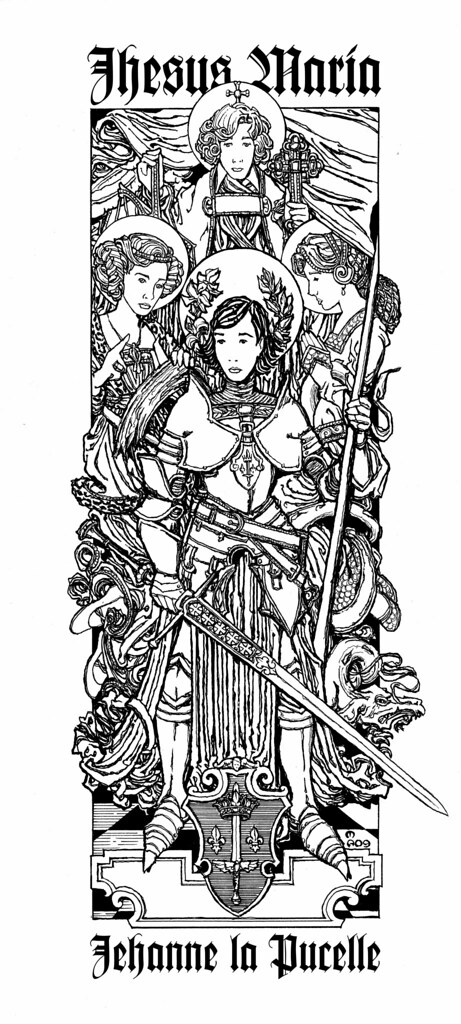Tuesday, January 26
New Line Art from Matthew Alderman

S. Joan of Arc with her Voices: SS. Michael, Katherine and Margaret. Ink (text added electronically here; original with text in ink), December 2009. Private Collection, Washington, D.C.
S. Joan of Arc would, on the surface, be an iconographic cakewalk: sketch a little dark-haired girl in armor, throw in a few fleurs-de-lys, her unmistakeable Jhesus Maria banner, a few angels, rinse and repeat. Yet, within that basic framework there are dozens of variations, some justly ubiquitous, and some which have embedded themselves in the pious mind without much logic in her personality or symbolic justification. Many second-rate holy cards show her as an irritatingly soulful Victorian heroine, and films like to show her as tall, feminine and stately--or in the case of the horrible The Messenger, as tall, psychopathic and androgynous. A good deal of evidence suggests the Maid of Orleans was rather on the short side, and while she managed to be both mystical and strangely street-smart in terms of commonsense, she was a commander and tactician, not a sword-slashing beserker. (She seems to have used the weapon she unearthed under the altar of Ste.-Catherine-des-Fierbois, after a vision guided her there, more as a field marshal's baton than an offensive weapon). She was also unmistakably female, if perhaps not always visibly feminine. Her armor and cropped hair were, after all, assumed out of convenience than preference: it is perhaps best to think of her as looking a bit like a college sophomore wearing her football player brother's equipment--sure of herself, sensible, level-headed, but just ever-so-slightly out of place.
So I tried to pick up on as much of this as I could in this image--making her strong yet young, maidenly yet military, and never just a St. George with a slightly different anatomy. Women can be as courageous and hardy as men, but they always bring something different to the table when are called on by God and circumstances to roll their metaphorical sleeves up. My first inclination was to try to avoid the swoony soft heroine we all know from chipped plaster statues--long hair, and often wearing a skirt over her armored legs, improbably considering her assumption of male dress off the field for both the protection of her chastity and as an effort to be taken seriously by the king and his knights. Not to mention the safety risk it might have posed. Certainly she might have worn a surcoat, and probably a rather rich one. But I was unsatisfied with the results, and opted for a modified bit of drapery, more for symbolic and artistic reasons--as a reminder that her strength and her identity as a woman are harder to separate than some revisionists might assume.
There are numerous other details scattered throughout the work alluding to her story--laurel leaves of victory paired with lillies of virginity round her halo, a somewhat operatically exaggerated version of the sword of St. Catherine with its five crosses, and the arms granted to her brothers that are still borne by the family to this day. These are shown at her feet and repeated on the breastplate of her armor, which also continues the laurel motif. I considered ornamenting her armor further, but wished to have it convey a beautiful practicality suited to her own personality and spirit.
I had the most fun in devising the figures of SS. Katherine and Margaret floating just over her shoulders. They are accompanied by their usual symbols of the broken spiked wheel and the trampled dragon. Their clothing repeats their story in more discrete ways. To the left, note the wheel-like braids of Katherine's hair, her royal crown, the lily of purity repeated at a medallion at her neck, the wedding ring of her mystical espousal, even the oratorical gesture of her right hand, suited to the expert rhetorician she was. The fur edging her tunic has a cheetah's spots, an animal (along with the panther) associated with Christ in the bestiaries and suggesting her exotic noble background, if perhaps in a roundabout mediaeval sort of way. Margaret's own costume repeats the dragon-scales of the serpent she triumphed over, as well as the pearls associated with her own name, which expand out into a number of other marine references, such as the net covering her hair). Her belt repeats the waves of smoke and water from one stage of her martyrdom where she was thrown into a boiling cauldron without result. (Note that she has rather calmly tucked the dragon's tail under her arm, a businesslike way of keeping the animal under control reminiscent of earlier depictions where she is shown with the animal on a leash.) Michael is shown above in the conventional manner, with his scales and the crossed stole and cope of an archpriest, a common dress for medieval angels showing their assisting role in the heavenly liturgy. Last but not least, we find overhead the words Jhesus Maria, the motto inscribed on S. Joan's famous banner.
Seeing S. Joan for what she was, more than just a Hollywood action girl, makes for a far more compelling story: it is hard not to find something to love and learn from in this subtle, clever, prayerful and even rather earthy young woman who, while possessing great physical courage in the thick of battle, was more than just a warrior.












